Universal Chalcidoidea Database
Notes on families
Trichogrammatidae
Main diagnostic characters
1. Minute to small insects 0.3-1.2mm in length, excluding ovipositor, or up to 1.8mm in length including the ovipositor (100%)
2. Not metallic (100%)
3. Funicle with not more than 2-segments (100%)
4. Tarsi 3-segmented (100%)
Included taxa
The family currently includes 83 genera and 839 species placed. No generally accepted subfamily classification has been proposed.
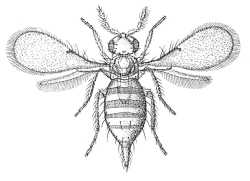 |
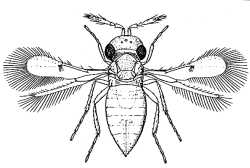 |
| (Brachista pungens) | (Oligosita pallida) |
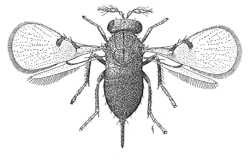 |
|
| (Ophioneurus longiclavatus) | |
Biology
Almost all trichogrammatids are primary, solitary or gregarious endoparasitoids of the eggs of other insects, notably those of Lepidoptera, Hemiptera, Coleoptera, Thysanoptera, Hymenoptera, Diptera and Neuroptera. One species of Trichogramma is known to occasionally develop as a facultative hyperparasitoid using a species of Telenomus in a lepidopteran egg as host (Strand & Vinson, 1984). A species of Lathromeris and one of Oligosita have been observed to develop as larval parasitoids of cecidomyiids (Diptera) (Viggiani & Laudonia, 1994).
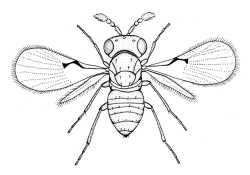 |
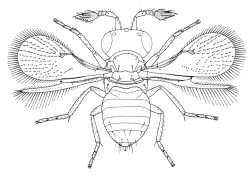 |
| (Trichogramma sp.) | (Trichogrammatoidea lutea) |
Many species oviposit directly into more or less exposed host eggs and some may even attempt to oviposit into anything that has the same size and shape as an egg, eg dried globules of sap. A few trichogrammatids parasitize the eggs of aquatic hosts, such as Dytiscidae, Notonectidae or Odonata, whilst the egg is beneath the surface of the water. These aquatic species (eg Prestwichia aquatica and Hydrophilita aquivolans) search for hosts by swimming underwater (Lubbock, 1864; Matheson & Crosby, 1912; Henriksen, 1922). A number of other trichogrammatids are phoretic. For example, in some species the adults attach themselves to adult tettigoniids in order to gain access to eggs which have been freshly laid (Ferriere, 1926). A South American species of the genus Xenufens is phoretic upon a nymphalid butterfly (Malo, 1961).
The eggs that have been described are at least a little elongate and sometimes slightly expanded centrally with both ends smoothly rounded (Flanders, 1937), or there may be a peduncle at one end (Silvestri, 1916; Bakkendorf, 1934). The first instar larva is usually one of two types, either sacciform (eg Chaetostricha and Trichogramma) or mymariform, (eg Poropoea). Some species may have an additional pre-apical curved, spine-like process (eg Ophioneurus). The mature larva is generally robust, distinctly segmented and without integumental spines or setae. The tracheal system seems to be lacking. Pupation takes place within the remains of the host egg, the adult parasitoid emerging by biting a hole in the chorion of the egg.
Many species of trichogrammatids are of interest because of their widespread use in the biological control of various insect pests, especially Lepidoptera (Walter, 1983a & b). In the field, parasitism rates may often reach 90 per cent. Most species that are used are mass reared under laboratory conditions and then released early in the season to try to control the pest species before its numbers can rise to cause economically significant damage.
Identification
Doutt & Viggiani, 1968 (world genera); Peck, Boucek & Hoffer, 1964 (Central European genera); Voegele & Pintureau, 1982 (species of Trichogramma); Nagarkatti & Nagaraja, 1977 (biosystematic literature on Trichogramma and Trichogrammatoidea); Pinto, 1998 (North American Trichogramma).
References
Bakkendorf, O. 1934a. Biological investigations on some Danish hymenopterous egg-parasites, especially in homopterous and heteropterous eggs, with taxonomic remarks and descriptions of new species. Ent. Meddel. 19:1-96.
Doutt, R.L. & Viggiani, G. 1968. The classification of the Trichogrammatidae (Hymenoptera: Chalcidoidea). Proceedings Calif. Acad. Sci. 35:477-586.
Ferrière, C. 1926. Un nouveau cas de phor,sie: trichogrammides sur sauterelles. Treubia 8(3/4):274-278.
Flanders, S.E. 1937. Starvation of developing parasites as an evolution of immunity. Journal of Economic Entomology 30(6):970-971.
Henriksen, K.L. 1922. Notes upon some aquatic Hymenoptera. Ann. Biol. Lacustre 11:19-37.
Lubbock, J. 1864. On two aquatic Hymenoptera, one of which uses its wings for swimming. Transactions of the Linnean Society of London 24:135-142.
Malo, F. 1961. Phoresy in Xenufens (Hymenoptera: Trichogrammatidae), a parasite of Caligo eurilochus (Lepidoptera: Nymphalidae). Journal of Economic Entomology 54(3):465-466.
Matheson, R. & Crosby, C.R. 1912. Aquatic Hymenoptera in America. Annals of the Entomological Society of America 5:65-71.
Nagarkatti, S. & Nagaraja, H. 1977. Biosystematics of Trichogramma and Trichogrammatoidea species. Annual Review of Entomology 22:157-176.
Peck, O., Boucek, Z. & Hoffer, A. 1964. Keys to the Chalcidoidea of Czechoslovakia (Insecta: Hymenoptera). Memoirs of the Entomological Society of Canada No 34:170pp, 289 figs.
Pinto, J.D. 1998. Systematics of the North American species of Trichogramma Westwood (Hymenoptera: Trichogrammatidae). Memoirs of the Entomological Society of Washington 22:1-287.
Silvestri, F. 1916. Contirbuzione all conoscenza del genre Poropoea F"rster (Hymenoptera, Chalcididae). Boll. Lab. Zool. Gen. Agr. Portici 11:120-135.
Strand, M.R. & Vinson, S.B. 1984. Facultative hyperparasitism by the egg parasitoid Trichogramma pretiosum (Hymenoptera: Trichogrammatidae). Annals of the Entomological Society of America 77(6):679-686.
Viggiani, G. & Laudonia, S. 1994. Description of a new species of Lathromeris Förster (Hymenoptera: Trichogrammatidae) larval parasitoid of Lasioptera sp. (Diptera: cecidomyiidae). Bollettino del Laboratorio di Entomologia Agraria 'Filippo Silvestri' 49:169-172.
Voegel,, J. & Pintureau, B. 1982. Caractàrisation morphologique des groupes et espèces du genre Trichogramma Westwood. Colloques de l'INRA No 9:45-75.
Walter, S. 1983a. The biology and ecology of egg parasites of the genus Trichogramma Westwood (Hym., Chalc.). Part I.: studies in selected forest biocoenoses in the G.D.R. Zoologische Jahrbücher, Abteilung für Systeamtik, Ökologie und Geographie der Tiere 110(3):271-299. (In German)
Walter, S. 1983b. Biological and ecological studies on egg parasites of the genus Trichogramma Westwood (Hym. Chalc.). Part 2. Investigations carried out under laboratory conditions. Zoologische Jahrbücher, Anteilung für Systematik, Ökologie und Geographie der Tiere 110(4):419-441. (In German).
Previous page | Next pageLast updated 05-Sep-2003 Dr B R Pitkin